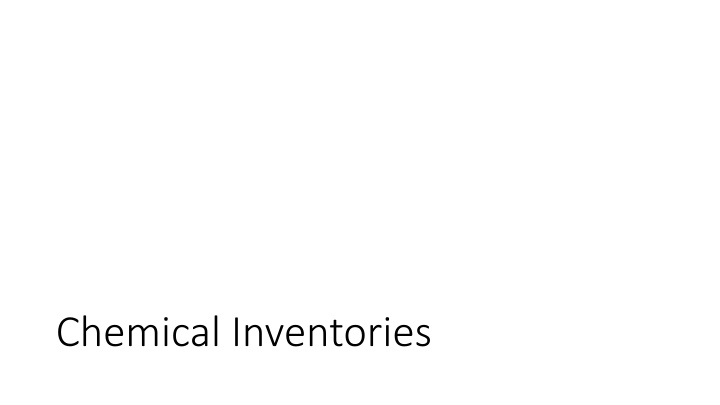Building a Comprehensive Chemical Inventory System
Conduct a thorough review of all processes to identify and document all chemicals used on-site, create a standardized inventory with relevant information, and use the inventory to prioritize hazardous chemicals for substitution, track usage quantities, and streamline purchasing practices to prevent overstocking and reduce waste. A chemical inventory serves as a vital tool in managing and regulating the usage of chemicals in a facility.
Download Presentation

Please find below an Image/Link to download the presentation.
The content on the website is provided AS IS for your information and personal use only. It may not be sold, licensed, or shared on other websites without obtaining consent from the author.If you encounter any issues during the download, it is possible that the publisher has removed the file from their server.
You are allowed to download the files provided on this website for personal or commercial use, subject to the condition that they are used lawfully. All files are the property of their respective owners.
The content on the website is provided AS IS for your information and personal use only. It may not be sold, licensed, or shared on other websites without obtaining consent from the author.
E N D
Presentation Transcript
Building Your Chemical Inventory Conduct a review of all production and support processes (maintenance, cleaning, power generation, etc.) to identify ALL chemicals used on-site Obtain and review chemical information of each chemical SDS RSL/MRSL testing Create a standardized inventory of all chemicals used Include relevant information on inventory
Chemical Inventory Good or Bad?? Department Name Hazard(s) Supply Vendor - Flammable - Health Hazard - Irritant (eye, skin) Dynex Chemical Gluing GL-100
Chemical Inventory Good or Bad?? Supply Vendor (Name, Address, Phone) Chemical Composition Container Quantity Department Trade Name CAS # % Composition Hazard(s) SDS # Methyl cyclohexane 108-87-2 45 50% Dynex Chemical Ltd., 144 Austin Rd, Hong Kong - 852 2345 5678 - Flammable - Health Hazard - Irritant (eye, skin) N-heptane 142-82-5 40 45% Gluing GL-100 SDS-005 25L Modified natural rubber N/A 10 15%
Chemical Inventory Good or Bad?? Revision Date: 01/21/2017 Example Chemical Inventory List On Approved Chemicals Lists? Annual Consumption to date Storage/Use Location Chemical Name % Quantity Stored # Process Supplier/Contact Chemicals CAS # SDS # Hazard Class Composition Flammable - category 3, Corrosive - Serious eye damage, category 1, Skin corrosion, category 1A Dye Kitchen - Production Storage A ABC Chemicals tel. (555)9393-2020 1 Fabric Dying Acetic Acid Yes Acetic Acid 99.99% SDS-01 250L 1500L 64-19-7 Silica 35% 7631-86-9 Environmental Hazard - Acute hazards to the aquatic environment, category 1 Dry Chemical Storage Chemstar 2 Fabric Dying LFS-200 Yes SDS-02 20kg 600kg tel. (555)2020-9393 Aluminum 65% 7429-90-5
Use Your Chemical Inventory Inventory = Database Can be separated by: Production areas Processes Product lines Departments Chemical hazards classes
Use Your Chemical Inventory Identify and prioritize hazardous chemical for substitution Restricted chemicals, significant human/environmental health impacts Track chemical usage quantities Can be used in the development and tracking of targets Identify any unknown chemicals on-site and regulate purchasing approvals Serves as a list of chemicals approved for purchase Standardize purchasing schedules and quantities Reduce over stocking, expiration Identify any redundant chemistries or areas of excessive use A chemical inventory is a living document that should be reviewed and updated regularly (at least every 6 months) by dedicated and trained staff






















